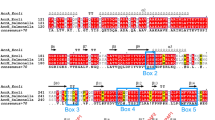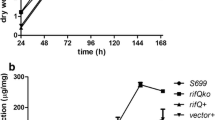Abstract
The rifamycin gene cluster in Amycolatopsis mediterranei includes the gene rifP, whose role in antibiotic production has not yet been established. In this work, the rifP gene was silenced and the results indicated that it codes for a protein to export rifamycin, avoiding its accumulation inside the cell. An antisense cassette was constructed by inserting the rifP gene in an antisense orientation downstream from the modified ermE* promoter, and upstream of the Tasd terminator (aspartate semialdehyde dehydrogenase of A. lactamdurans). Partial silencing of the rifP gene by the use of the antisense cassette, cloned in the plasmid pUAMAE5, resulted in a 70% decrease in the extracellular rifamycin B. A protein of 53 kDa was absent in the membrane fraction of the silenced strain. This is the same size of the expected product from the rifP gene. The 2D structure analysis indicated it belongs to a Drug:H+ antiporter family which includes a wide number of membrane transport proteins.







Similar content being viewed by others
References
August P, Tang L, Ion Y, Ning S, Muller R, Yu T, Taylor M, Hoffmann D, Kim C, Zhang X, Hutchinson R, Floss H (1998) Biosynthesis of the ansamycin antibiotic rifamycin: deductions from the molecular analysis of the rif biosynthetic gene cluster of Amycolatopsis mediterranei S699. Chem Biol 5:69–79
Bibb MJ, Janssen GR, Ward JM (1985) Cloning and analysis of the promoter region of the erthromycin resistance gene (ermE) of Streptomyces erythraeus. Gene 42:E357–E362
Blanc V, Salah-bey K, Folcher M, Thompson CJ (1995) Molecular characterization and transcriptional analysis of a multidrug resistance gene cloned from the pristinamycin producing organism, Streptomyces pristinaespiralis. Mol Microbiol 17:989–999
Caballero JL, Martínez E, Malpartida F, Hopwood DA (1991) Organization and functions of the actVA region of the actinorhodin biosynthetic gene cluster of Streptomyces coelicolor. Mol Gen Genet 230:401–412
Cho YH, Kim EJ, Chung HJ, Choi JH, Chater KF, Ahn BE, Shin JH, Roe JH (2003) The pqrAB operon is responsible for paraquat resistance in Streptomyces coelicolor. J Bacteriol 185:6756–6763
Floss HG, Yu T-W (1999) Lessons from the rifamycin biosynthesis gene cluster. Curr Opin Chem Biol 3:592–597
Folcher M, Morris R, Dale G, Salah-Bey-Hocini K, Viollier P, Thompson C (2001) A transcriptional regulator of a pristinamycin resistence gene in Streptomyces coelicolor. J Biol Chem 276(2):1479–1485
Kumar C, Coque J, Martín JF (1994) Efficient transformation of the Cephamycin C producer Nocardia lactamdurans and development of shuttle and promoter-probe cloning vectors. Appl Environ Microbiol 60:4086–4093
Lee C, Kamitani Y, Nihira T, Yamada Y (1999) Identification and in vivo functional analysis of a virginiamycin S resistance gene (varS) from Streptomyces virginiae. J Bacteriol 181(10):3293–3297
Margalith P, Pagani H (1961) Rifomycin. XIV Production of rifamycin B. Appl Microbiol 9:325–333
Mejia A, Barrios-González J, Viniegra-González G (1998) Overproduction of rifamycin B by Amycolatopsis mediterranei and its relationship with the toxic effect of barbital on growth. J Antibiot 51:58–63
Mejia A, Viniegra-González G, Barrios-González J (2003) Biochemical Mechanism of the Effect of Barbital on Rifamycin B Biosynthesis by Amycolatopsis mediterranei: (M18 Strain). J Biosc Bioeng 95(3):288–292
Moretti P, Hintermann G, Hutter R (1985) Isolation and characterization of an extrachromosomal element from Nocardia mediterranei. Plasmid (14):126–133
Putman M, Van Veen H, Konings W (2000) Molecular properties of bacterial multidrug transporters. Microbiol Mol Biol Rev 64(4):672–693
von Heijne G (1992) Membrane protein structure prediction. Hydrophobicity analysis and the positive-inside rule. J Mol Biol 225(2):487–494
Xu J, Eva W, Chag-Joon K, Floss HG, Mahmud T (2005) Identification of tailoring genes involved in the modification of the polyketide backbone of rifamycin B by Amycolatopsis mediterranei S699. Microbiology 151:2515–2528
Acknowledgments
The authors thank to Professor Heinz G. Floss (Department of Chemistry, University of Washington, Seattle U.S.A.) for providing A. mediterranei S699 strain. This work was supported by Consejo Nacional de Ciencia y Tecnología (CONACyT, México.) (Grant SEP-2003-C02-44911).
Author information
Authors and Affiliations
Corresponding author
Rights and permissions
About this article
Cite this article
Absalón, A.E., Fernández, F.J., Olivares, P.X. et al. RifP; a membrane protein involved in rifamycin export in Amycolatopsis mediterranei . Biotechnol Lett 29, 951–958 (2007). https://doi.org/10.1007/s10529-007-9340-7
Received:
Revised:
Accepted:
Published:
Issue Date:
DOI: https://doi.org/10.1007/s10529-007-9340-7




